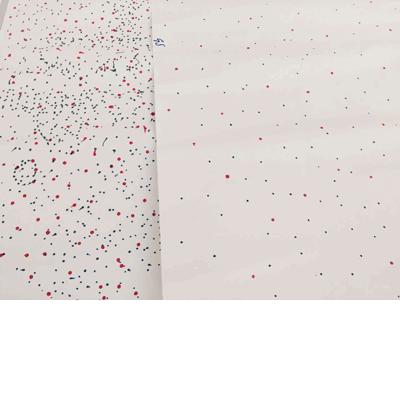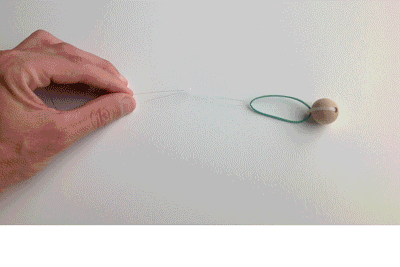Rule
End each turn with a perfect circle which is larger than the previous one. Each person must take 60 seconds to take their turn. Finish when you reach the end of the page.
The Perfect Circle
The Perfect Circle

Initial setup
• Play with four players.
• Each player as a colored pen: red, green, blue and black.
• Each player places a dot on the sheet at an arbitrary position but
not further than 10 cm from each other.
• The players take turns
Task to be performed every turn by each player
Draw a straight line
1. The line must connect two dots.
2. The angle of the line must be within the following range: 0 to
45 degrees for the black lines, 45 to 90 degrees for the blue lines,
90 to 135 degrees for the red lines, 135 to 180 degrees for the green
lines.
3. Connect the line to an existing line if possible.
4. Draw the shortest possible line from your starting point. If you enclose an area (a plane surrounded
by lines) then hatch it with lines parallel to the line you enclosed the area with. The enclosed area
may not contain unconnected dots or open ended lines.
Place a dot
The position of the dot is not further away than 10 cm from other dots and not inside the convex hull of
all dots.
Hatching
Hatching
Each turn, find the most empty space on the paper and place a dot in the middle of it. Do this as quickly as you can in 5 minutes.
The Beach
The Beach
This workshop came from a desire to play with triangle based 3D structures as opposed to rectangular based 3D structures. Marvin Minsky, a famous cognitive scientist in the field of artificial intelligence, makes a clear distinction between these two principles for making rigid structures in the video segment Tinker Toys versus Lego
Workshop with Edo Paulus at Moniker, thursdays.studiomoniker.com conditionaldesign.org.

On one end of your fishing line attach a rubber band. With a tie wrap, connect the rubber band to a bead.
From the open end of your fishing line, string all your straws of one color onto the fishing line.
Just before you add the last straw, attach the second rubber band to the fishing line.
Pull the rubber band through the last straw so that it’s just slightly tensed when exiting the last straw and connect the rubber band to the second bead. Leave the remaining fishing line attached for now.
You now have one long string of 100 straws that are gently held together by the fishing line and rubber bands. Where the straws meet, they can still make angles in all directions.
All players together:
Connect the beginning of each of your fishing lines together into one central point: Remove the beads and bind the ends together with one tie wrap.
Play
Each player will play with the string of 100 straws it just prepared.
The players take turns.
The first player makes a triangle by using a tie wrap to bind the fishing line at the breakpoint between the third and fourth straw to the central point of all the long strings of straws. This triangle will become the start of a three dimensional structure build up of straws connected to each other by fishing lines and tie wraps.
Each following turn:
* • Add the next one or two straws from your long string of straws to the main, central structure: Use a tie wrap to bind the fishing line at the breakpoint after the first or second free straw to a breakpoint on the main structure.
* • Don’t force the main structure so that straws would bend, break or contort.
* • Don’t attach two parallel straws right next to each other.
* • It’s a gentleman’s agreement to add only one straw, if possible.
* • Use scissors to cut off the remaining end of the tie wrap.
End
It ends when all straws from each long string of straws are connected to the central structure with tie wraps.
Source: https://www.conditionaldesign.org/workshops/3d-straw-structure/
Final Project
- Conditional Design
Final Project
- Conditional Design
> click here to see the conditional design work
HOME